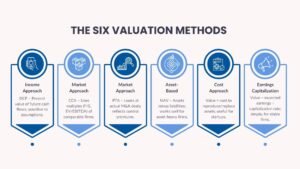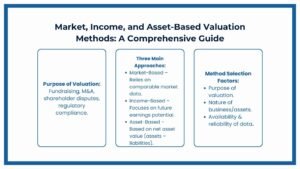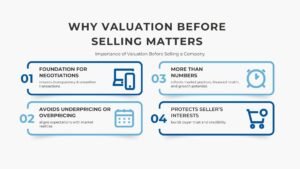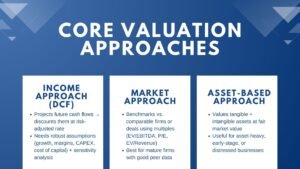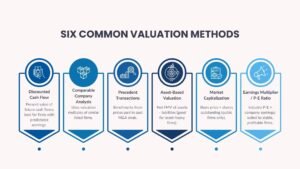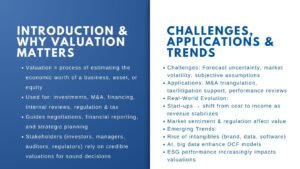
What Are the 6 Practical Methods to Value Companies
Learn What Are the 6 Practical Methods to Value Companies
Learning to value a company is considered core to all investment decisions, mergers and acquisitions, financial reporting and strategy formation. Be it as a startup founder planning a funding round, a corporate buyer considering an acquisition target, or a financial expert in due diligence, a familiarity with the various valuation methodologies can ensure you have the right idea of how to go about your evaluation, and make a better informed decision with the support of company valuation services in Singapore.
Valuing a company is not an exact science—it is both a distillation of financial theory, market dynamics and professional expertise. There is no standard approach, but six common and simple techniques are used to how to value a company in Singapore. All of the methods represent various points of view to the value and can yield various outcomes based upon the character of business, its capital structure, business environment, and government, making them among the top methods for private company valuation Singapore.
The Income Approach: Discounted Cash Flow (DCF) Method
Income approach is perhaps the most acceptable theoretical and employed valuation techniques. Discounted Cash Flow (DCF) technique is concerned with the forecast-cash flows that a business entity is supposed to earn, then discounting it back to the present, based on a suitable rate of discount.
The assumption by this approach is that the value of business is taken to be the present value of the benefits upon the future which is anticipated. The DCF technique entails estimating cash flow over a particular subjection span, and incorporating an extra terminal measure to recognize the future performance past the limit and multiplying the total by an index that overlooks the time value and takes into account the riskiness.
DCF is especially helpful in valuing a company whose cash flows are rather steady and predictable, like an old and established company or infra-structure. It is, however, sensitive to assumptions in respect to growth rates, margins, capital and discount rates. Changing by small margins of assumption can have huge effects on the final valuation which makes the use of this method to require expertise and care.
The Market Approach: Comparable Company Analysis (CCA)
Comparable Company Analysis (CCA) is based on the assumption that similar companies are supposed to possess similar valuations. This approach entails identifying publicly traded firms that are comparable to the target firm in both industry and size as well as in growth profile and financial ratios and basing valuation multiples off of these publicly traded firms.
Enterprise Value-to-EBITDA (EV/EBITDA) Price-to-Earnings (P/E) and Enterprise Value-to-Revenue ( EV/Revenue) are the most popular valuation multiples. Using such multiples against the financial indicators of the business that is being valued, an approximate relative value of the business is determined.
CCA has a preference in that it is a market based mechanism and is representative of the current investor sentiment and real time pricing information. But it is not always easy to identify really comparable firms and differences in the industry risk, capital structure, and the model of the business can skew comparisons. Nevertheless, it is a fast and convenient tool, especially in a rapidly developing environment, like technology or consumer services.
The Market Approach: Precedent Transaction Analysis (PTA)
Precedent Transaction Analysis (PTA) is closely related with the above discussed comparable company analysis. Rather than focusing on trading multiples, this is a price based method that analyzes known transactions between companies similar to one another operating in the same industry. This is more useful in M&A situations because it gives an indication of what strategic or financial buyers were prepared to pay in actual transactions.
PTA is a process by which past deals are identified and analyzed in terms of important deal parameters, deal size, multiple valuation and the form of deal. It gives an understanding of the acquisition premiums and industry trends. PTA can be particularly useful in the acquisition context compared to the comparisons using prices in the public markets as it reflects the control premiums.
Nonetheless, this may be hard to get since the data on previous transactions are not readily available, at least not in the private market. Every transaction too reflects certain circumstances; strategic motifs, market and time element; none of which might be similar to the company under analysis. However, PTA is an effective method to measure market appetite when it is analyzed in an intelligent manner to understand the norms of pricing deals.
The Asset-Based Approach: Net Asset Value (NAV)
The asset-based approach uses the value of the underlying goods and debts of the company. The most popular here is the Net Asset Value (NAV) that is obtained after taking the fair market value of assets minus any total liabilities.
NAV is particularly appropriate in companies, which have a lot of assets, and tangible assets (real estate, equipment, or inventory) make up a sizeable proportion of the company value. The same approach is also applicable in circumstances where a business is under liquidation or being restructured where the assets value remains the major point.
Although simple in practice, the asset-based method is unfavorable to businesses that get the majority of their value through intangible assets like brand, intellectual property or customer relationships. It is not suitable enough in cases where the service or technology business is not orientated towards value creation on the basis of physical assets. However, it may represent a floor value or a floor valuation, in particular where the market or income information is hard to decipher.
The Cost Approach: Reproduction or Replacement Cost
Cost approach is the method in which they estimate the cost of producing or replacing the assets and abilities of a firm. This involves price of replacing the company as a new entity to attain the same utility or performance both in terms of tangible and intangible assets.
The method is particularly applicable when valuing startups at an early stage, research-intensive company, or company with large proprietary technology. An example is an estimate of costs of developing an application program, product prototype, or a skilled development team to hire and train as a proxy to measure the value in a company.
The negative aspect is the fact that the cost approach fails to recognize the profitability, competitive advantages, and market positions. It presupposes that the cost of creation is equal to the value and it does not necessarily correspond in the fast-moving or highly competitive markets. It is still a helpful measure of investment risk and possible reward, however, in the scenario that there are no earnings or revenue, or assuming that the business is pre-revenue.
The Earnings Capitalization Method
The other income based technique is the earnings capitalization method in which a firm is valued by dividing expected future earnings by capitalization rate. This method presupposes that earnings will be constant in the long run and is most applicable to those businesses whose revenue is regular and predictable as well as with low volatility.
Contrary to the DCF process in which multi-year effects to the cash flows are needed, the earnings capitalization process involves using a single indicator of earnings, usually net income or EBITDA, and is capitalized at a multiplier based on the required rate of return including risk adjustments in the capitalization process.
This is usually the approach applied in valuation of a small business, professional practice and other operations that are related to real estates. Although it is not as detailed or flexible as DCF, it provides an at-a-glance and more time efficient method of valuation when financial forecasting is possible.
Choosing the Right Method for the Job
There is always a weakness in any valuation method and none of the methods is universal; however the best method to use depends on the intent of the valuation, the type of company and the availability of data. The analysts triangulate a reasonable valuation range through a combination of the methods in many cases. As an example, DCF can be adopted with the help of similar company analysis and precedent transactions to ensure a balanced point of view.
It depends on context. The focus can be on asset-based approaches in a tax or litigation setting. With investment banking or in the case of the private equity market, multiples are market-based as well as DCF. In the meantime the methods of startup or venture valuation, cost based and earnings capitalization methods can provide more clarity.
Any other factor that is considered is the maturity of the business, accessibility of accounts or financial statements of the business, regulatory issues and also whether a minority or control valuation is being sought. Each one of these methods achieves its advantages and blind spots; this is why professional judgment continues to be relevant in the interpretation of results.
Final Thoughts on What Are the 6 Practical Methods to Value Companies
The valuation of a company is an art as well as a science. The models and calculations can be technical in nature but the result depends radically upon market insights, strategic insights, and value drivers clarity. These six practical techniques described below ( Discounted Cash Flow, Comparable Company Analysis, Precedent Transactions, Net Asset Value, Cost Approach, and Earnings Capitalization) provide a well-rounded collection of tools to tackle various types of valuation engagements confidently.
Finally, valuation is not a numbers game only, it is about the story telling. An inspirational tale about the performance, potential and market place of a firm. And to narrate and convey it in a good way, it is worth selecting the correct lens through which that story can be assessed and interpreted.


